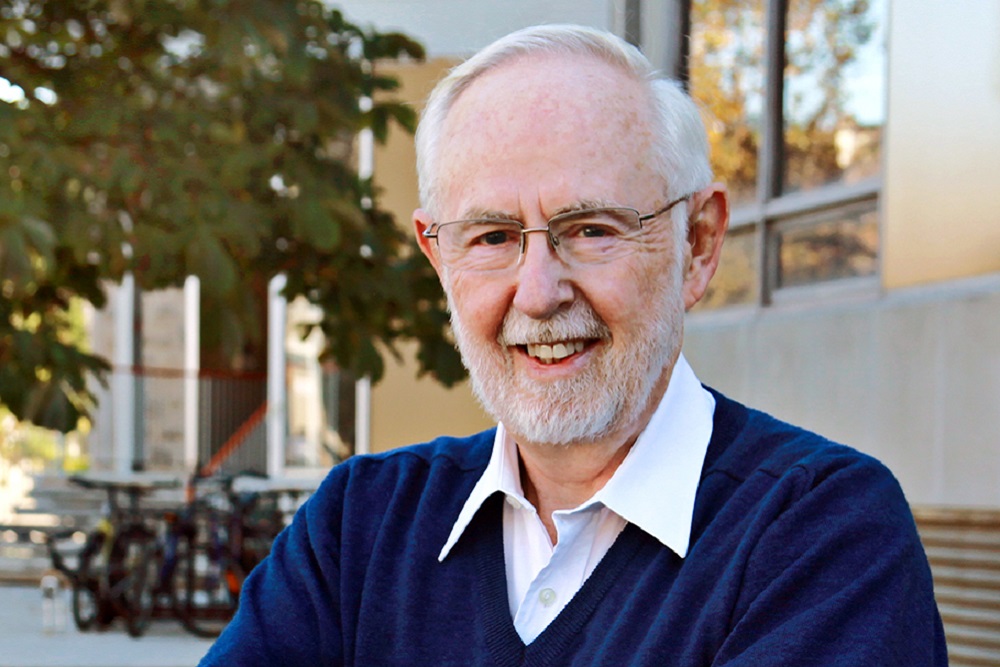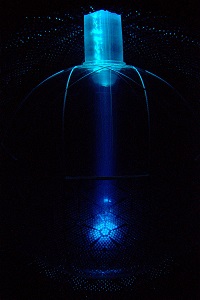A career exploring the mysteries of the universe
July 20, 2022
Share

Understanding the building blocks of the universe and how they interact with each other has been the primary goal for Arthur McDonald over his illustrious career that spans six decades. An expert in astroparticle physics, he is behind some of the most important discoveries in the field, and, in 2015, was awarded a Nobel Prize for his research showing neutrinos – one of the smallest particles known to science – have mass.
Dr. McDonald’s Nobel Prize-winning research took place at a state-of-the-art underground facility in Ontario, the Sudbury Neutrino Observatory (SNO). After revolutionizing our understanding of neutrinos and the core of the Sun with SNO – an experiment that included more than 200 researchers from 14 institutions, the underground laboratory was expanded in 2012 to become SNOLAB, the world’s deepest ultra-clean lab situated two kilometers underground and dedicated primarily to neutrino and dark matter experiments. These topics are regularly included in the top 10 list of priorities for physics studies internationally.
As Gordon and Patricia Gray Chair in Particle Astrophysics Emeritus within Queen’s Department of Physics, Engineering Physics & Astronomy, Dr. McDonald continues his quest to unravel the universe’s deepest secrets. Recently, in June, Dr. McDonald, along with Nobel Laureate Donna Strickland (University of Waterloo), was an inaugural recipient of the Canadian Association of Physicists Fellowship, a career honour recognizing contributions to physics research and education, leadership within the Canadian physics community and inspiring the next generation of physics graduates.
In this interview with the Gazette, Dr. McDonald reflects on milestones, Canadian leadership in astroparticle physics, and the next frontiers in the field.
We understand this is an exciting year for astroparticle physics in Canada. What are our main reasons to celebrate?

We are actually celebrating a double anniversary: 20 years since we obtained our first significant results in the SNO experiment and the 10-year anniversary of SNOLAB, building on the SNO experiment.
SNOLAB has been a very substantial success. In terms of research, it provides a focal point, an opportunity for Canadian scientists to be involved in experiments at the forefront of astroparticle physics – a field that explores both the physics of particles and their place within the overall evolution of the universe.
Being deep underground, SNOLAB is one of the world’s two laboratories with the lowest level of cosmic rays and is the lowest radioactivity laboratory that has ever been created for scientific activities. That provides an opportunity to do cutting edge measurements.
SNOLAB has delivered several significant scientific results and set itself up as the location of choice for some of the most important international experiments in the future. They will seek to further understand both neutrinos and dark matter, and thereby adding to our understanding of how the universe has evolved since the Big Bang.
What big challenges are you addressing with your current research?
There are two, I believe. One is attempting to observe dark matter directly. We know that dark matter has gravitational effects on our Galaxy. In fact, it is what holds the glowing stars in their rotation pattern in a Galaxy like ours. In the spaces between the stars on a clear night gravitational effects tell us that there is five times more mass in dark matter than in the stars themselves.
But dark matter particles appear to have properties that are different than anything we have seen to this day. It's a new form of matter that may well have been produced in the Big Bang but not observed directly in experiments to date. Directly observing dark matter through its interaction with ordinary matter is a major topic in particle astrophysics.
Beta decay is a common form of radioactivity, where a neutron in an atom’s nucleus changes into a proton, an electron and an anti-neutrino. In very few cases, the nucleus doesn’t have the energy to produce those three particles and emits two electrons and two anti-neutrinos (that’s a double-beta decay). But there’s a third possibility – one that is only theoretical and hasn’t been observed: that the nucleus emits only two electrons, but no neutrinos. In this case, the neutrinos that would have been emitted by the nucleus annihilate each other, which is why physicists named the phenomenon a neutrinoless double-beta decay. This only can occur for very specific properties of neutrinos that can have a substantial influence on the evolution of the universe since the Big Bang.
The other major topic is neutrinoless double-beta decay (see sidebar). We are trying to observe that rare phenomenon to tell us more about detailed properties of neutrinos, including their absolute mass and symmetries that can influence how the universe has evolved.
I am working with collaborators worldwide on these two topics right now, pushing the sensitivity of our experiments. I would be overjoyed if either one of these searches observe the phenomena of interest, but even setting limits in the experiments can constrain theories of physics at a very basic level.
How do you see Canada taking a leadership role in astroparticle physics research?
Canada has a leadership role in part because of the existence of SNOLAB, which, as mentioned, has become the underground location of choice for cutting edge experiments.
The other element is the McDonald Institute, located at Queen’s and funded by the Canada First Research Excellence Fund. Under the leadership of Tony Noble, it created new faculty positions across Canada, in partnership with a number of universities. The institute formed a new generation of faculty members who are proposing new things, participating in major projects, and educating a tremendous number of students.
Through the McDonald Institute and SNOLAB, Queen’s has been a champion in supporting this field in partnership with other Canadian universities. It has the largest astroparticle physics group in Canada and one of the largest internationally, with significant multidisciplinary connections.
What are some of the current projects carried out at SNOLAB?
Several experiments at SNOLAB are trying to observe dark matter particles directly. Although dark matter makes up about 85 per cent of the matter in the universe, we don’t really know its basic physical properties.
SNOLAB is studying dark matter particles that could interact with ordinary matter.
The PICO experiment has, for example, the most sensitivity achieved so far anywhere in the world for particles that are interacting primarily due to the inherent spin of the target nucleus- fluorine. The DEAP-3600 has set the most stringent limit for dark matter particles interacting with liquid argon, that has zero spin on the nucleus. The NEWS-G experiment uses gases like helium and nitrogen to study some of the lowest energy interactions that are possible to measure. By using target materials with different properties we can search for the basic properties of the dark matter that we know is in our galaxy and passing through our detectors constantly.
We have taken advantage of this world leading low radioactivity laboratory to make measurements that otherwise would be impossible on the surface of the Earth.
SNOLAB also allowed us to continue the SNO project, now referred to as SNO+, currently led by Mark Chen. This experiment has a potential to use the valuable infrastructure of the SNO detector, to study neutrino-less double beta decay and attempt to answer the next most important questions about the properties of neutrinos.